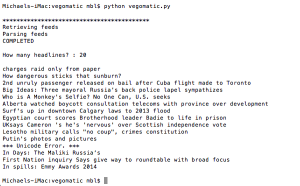
About a year and a half ago, I stopped posting updates on Twitter from my account @nscadesign. I had become increasingly uncomfortable with that service’s ethical behaviour—in particular I was troubled with a sense that Twitter enforces its Terms of Service for some but not others. To stop using my personal Twitter account was not difficult; I’d not posted very much anyway. Media Circus, however, uses tweets as headline content that I manage through the account @generalxcentic and around that time l began to consider dropping Twitter and moving to something else. Other more pressing matters would place this issue on the back burner, until Media Circus stopped working at the end of July.
At that point I did some poking around. The last time Media Circus stopped performing was around the same time of year in 2016: I identified the problem with a change in my home internet service’s IP address. I changed Media Circus’s code so that it used the Dyn service. Problem solved.
This time the problem seemed to be related to the php code library called “Magpie” that I used to convert the tweets to RSS. It was broken and Magpie didn’t seem to be maintained.
So I decided to cut through the Magpie step, and drop Twitter as well. Instead, I’ve written a Python script that resides on the same Raspberry Pi server as before, but the content resides entirely on that machine: a master list of over 1200 headlines (re-used from before) of which ten are selected every morning. Media Circus retrieves this daily headline list when it does its daily reboot.


